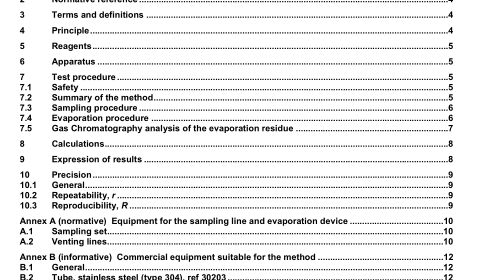EN 15470:2007 – Liquefied petroleum gases – Determination of dissolved residues – High temperature Gas chromatographic method

1 Scope
This European Standard specifies a method for determining the dissolved residual matter in liquefied petroleum gases (LPG), in the range of 40 mg/kg to 100 mg/kg. Higher concentrations can be determined by adjusting the sample size.
The dissolved residue is the amount of organic compounds that are detectable by gas chromatography after evaporation of the sample at ambient temperature and then in an oven at 105 °C. This method is not suitable for detecting solid materials or for possibly high molecular weight polymers (> 1 000 g/mol). The advantages of this method are that a small quantity of LPG (50 g to 75 g) is required and the qualitative data available may indicate the origin of the residues (gas-oil, lubricants, plasticizers, etc.).
This method has been developed as a potential replacement of the commonly used method described in EN ISO 13757 [1], but is safer and more environmentally friendly. In addition, this new method is more accurate.
The precision data of the method have been determined from 20 mg/kg to 100 mg/kg. For a higher content of residue, the precision has not been tested, but remains of lesser interest as typical specifications are in the range of 20 mg/kg to 100 mg/kg.
NOTE An alternative European Standard, EN 15471 [2], specifies a gravimetric method, which has the same scope and slightly worst fidelity data. WARNING — Use of this method involves hazardous materials and operations. It is the responsibility of the user to establish appropriate safety and health precautions. All handling must be performed in a fume hood.
2 Normative reference
The following referenced documents are indispensable for the application of this document. For dated references, only the edition cited applies. For undated references, the latest edition of the referenced document (including any amendments) applies.
EN ISO 4257, Liquefied petroleum gases – Method of sampling (ISO 4257:2001) 3 Terms and definitions For the purposes of this document, the following term and definition applies.
3.1 liquefied petroleum gas (LPG) petroleum gas that can be stored and/or handled in the liquid phase under moderate conditions of pressure and at ambient temperature, consisting predominantly of propane, butanes, with small proportions of propene, butenes and pentanes/pentenes 4 Principle A known mass of LPG, between 50 g and 75 g, is sampled and evaporated in a standard small glass flask. The residue is heated in an oven at 105 °C for 1 h.
It is then diluted with a solvent and one internal standard is added. The mixture is then analyzed by a capillary gas chromatography and quantified by the internal standard method.
EN 15470:2007 – Liquefied petroleum gases – Determination of dissolved residues – High temperature Gas chromatographic method